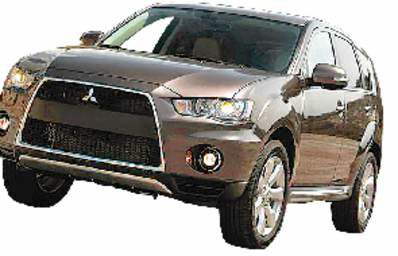A fair-weather friend only
Published 4:00 am Sunday, February 21, 2010

- The 2010 Mitsubishi Outlander XLS is an all-wheel-drive crossover utility vehicle but was no match for severe winter weather. Also, the redesigned grille is pretty unimpressive.
CORNWALL, N.Y. — The drive turned nasty on northbound Interstate 87 in upstate New York, where strong crosswinds, sleet and light snow joined in ridicule of Mitsubishi’s advertising claims.
The butts of the joke were me and the 2010 Mitsubishi Outlander XLS crossover utility vehicle, which waved back and forth in the manner of a kite’s tail. I hadn’t expected that, having fallen for the joy of an inapplicable memory.
Trending
I had last driven an Outlander in 2003, the year of its introduction in the United States. I was impressed. It behaved beautifully, had myriad amenities and was put together as well as several of its more expensive rivals.
But the weather was nice that spring week in 2003, driving in Virginia’s Shenandoah Valley. Love was abloom. I applied that emotion in large measure to the Outlander.
Saying yes to the 2010 Outlander was easy when it came around, although it came with winter storm warnings throughout the East Coast.
But I was overconfident in the Outlander XLS crossover’s Super All Wheel Control (S-AWC) drive system, supposedly one of the best all-wheel-drive arrangements in the motoring world. Also, I was overconfident in my driving skills.
My friend, Lou Ann Hammond, an automotive writer in Northern California, always advises her colleagues, “Don’t drive faster than your angels can fly.” She has a corollary: “Using your head is better than losing your butt.”
I should have listened. But Mitsubishi’s S-AWC drive system was so seductive — especially in print and on roads uncompromised by strong winds and ice. I didn’t listen and almost lost my butt — several times.
Trending
I’ll reflect more on one of those near-misses later. But first, I’ll share some information on Mitsubishi’s S-AWC drive system:
It is a good all-wheel-drive arrangement, arguably one of the best available. It uses an electronically controlled active front differential in tandem with electronic traction and stability control to shift power left to right, wheel to wheel. As such, S-AWC balances the Outlander’s weight shifts, allowing greater acceleration in turning corners and reducing the chances of slipping and toppling.
S-AWC works well. But it can’t and won’t override the laws of physics. A slippery, icy road is a slippery, icy road. A strong wind is a strong wind. The two together will upset any vehicle, regardless of size, technology, engineering or build quality.
The Outlander XLS got pushed around — badly. Its rear end swung out of sync several times, once strongly aided by the wind, which moved it rightward over an icy patch of I-87 toward the shoulder of the road. Luckily, I chose to hug a right lane where traffic was sparse. But keeping the Outlander upright and moving in a straight line in that windy, wintry mix proved far more difficult than I would have ever imagined.
The experience taught me several lessons. One, too many automotive advertisements don’t deal with reality. All of the on-air braggadocio about how well one car or another could run in snow or other bad weather is braggadocio — and dangerous braggadocio at that. Sometimes, as Lou Ann suggests, it’s better to keep your engine off, your butt off the road and stay put.
Lesson two: No car company anywhere can make a car, truck, SUV or crossover utility vehicle that can trump Mother Nature at her most brutal. If you doubt that, check the Department of Transportation’s Fatality Analysis Reporting System. The charts are filled with her victims. I almost became one of them.
The bottom line
Complaints: Its faulty automotive advertising, especially those ads showing cars and trucks rip-roaring along off-road paths or along severely weather-compromised roads. Disclaimers citing the drivers in those advertisements as “professional” or their various driving environments as “closed” are not enough. I suggest: “Not a single one of us in this business has found a way to override the laws of physics. Attempting to do so can be fatal.” Also: The XLS needs an all-wheel-drive system as good as the S-AWC, which works well in tandem with the electronically controlled front differential, stability and traction control.
Ride, acceleration and handling: The Outlander is good in all three categories when used as designed.
Head-turning quotient: Ugly. The front end, refashioned for 2010, looks like the upside-down face off an Audi A4.
Capacities: The Outlander XLS can seat five or seven people. (Hint: Take the five-passenger arrangement.) Cargo capacity is 73 cubic feet with rear seats down, 14.9 cubic feet with rear seats up.
Safety: Standard four-wheel disc brakes, anti-lock brake protection, Super All Wheel Control drive system, electronic stability and traction control.
2010 Mitsubishi Outlander XLS
Base price: $26,390
As tested: $31,354
Type: Compact, front-engine, car-based entry-level crossover utility vehicle with four side doors and a rear hatch
Engine: Standard 3-liter, 24-valve, V-6 mated to a six-speed automatic transmission that also can be shifted manually.
Mileage: 18 mpg city, 24 mpg highway








